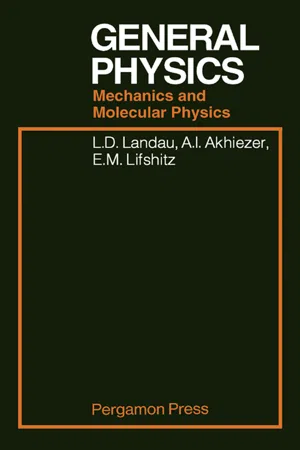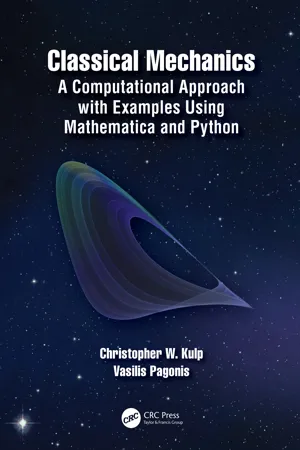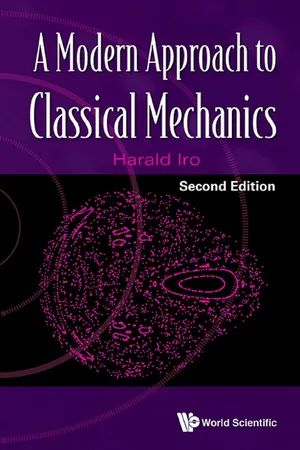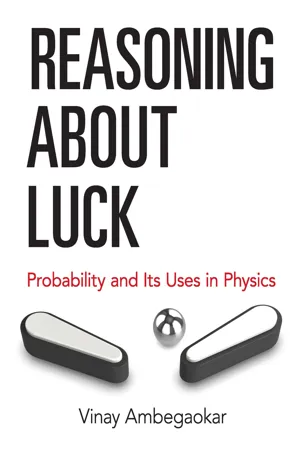Physics
Motion of a Particle
The motion of a particle refers to its change in position over time. It can be described in terms of displacement, velocity, and acceleration. Understanding the motion of a particle is fundamental in physics and is often analyzed using mathematical equations and graphical representations to study its behavior and predict future motion.
Written by Perlego with AI-assistance
Related key terms
6 Key excerpts on "Motion of a Particle"
- eBook - ePub
General Physics
Mechanics and Molecular Physics
- L D Landau(Author)
- 2013(Publication Date)
- Pergamon(Publisher)
CHAPTER I PARTICLE MECHANICS Publisher Summary The fundamental concept of mechanics is that of motion of a body with respect to other bodies. The relativity of motion arises from the relativity of the concept of space itself. This chapter discusses the principle of the relativity of motion. It is reasonable to begin the study of the laws of motion by considering the motion of a body of small dimensions. The motion of such a body is especially simple because there is no need to take into account the rotation of the body or the relative movement of different parts of the body. A body whose size may be neglected in considering its motion is called a particle and is a fundamental object of study in mechanics. The possibility of treating the motion of a given body as that of a particle depends not only on its absolute size but also on the conditions of the physical problem concerned. The position of a particle in space is defined by specifying three coordinates, for instance, the three Cartesian coordinates x, y, z. For this reason, a particle is said to have three degrees of freedom. The Motion of a Particle is described by its velocity. The chapter also discusses momentum, motion under reactive forces, centre of mass, acceleration, force, dimensions of physical quantities, motion in a uniform field, work and potential energy, the law of conservation of energy, internal energy, boundaries of the motion, elastic collisions, and angular momentum. Besides energy and momentum, another vector quantity called angular momentum is conserved for any closed system. This quantity is the sum of the angular momenta of the individual particles - eBook - ePub
- Hiqmet Kamberaj(Author)
- 2021(Publication Date)
- De Gruyter(Publisher)
4 Two- and three-dimensional motionIn this chapter, we will discuss the kinematics of a particle moving in two and three dimensions. Utilizing two- and three-dimensional motion, we will be able to examine a variety of movements, starting with the motion of satellites in orbit to the flow of electrons in a uniform electric field. We will begin studying in more detail the vector nature of displacement, velocity, and acceleration. Similar to one-dimensional motion, we will also derive the kinematic equations for three-dimensional motion from these three quantities’ fundamental definitions. Then the projectile motion and uniform circular motion will be described in detail as particular cases of the movements in two dimensions.4.1 The displacement, velocity, and acceleration vectors
When we discussed the one-dimensional motion (see Chapter 3 ), we mentioned that the movement of an object along a straight line is thoroughly described in terms of its position as a function of time,x ( t ). For the two-dimensional motion, we will extend this idea to the movement in thex yplane.As a start, we describe a particle’s position by the position vector r pointing from the origin of some coordinate system to the particle located in thex yplane, as shown in Fig. 4.1 . At timet ithe particle is at point P, and at some later timet fit is at the position Q. The path from P to Q generally is not a straight line. As the particle moves from P to Q in the time intervalΔ t =, its position vector changes fromt f−t ir itor f.Definition 4.1 (Displacement vector).
The displacement is a vector, and the displacement of the particle is the difference between its final position and its initial position. We now formally define the displacement vector for the particle as the difference between its final position vector and its initial position vector:(4.1)Δ r =r f−r i.The direction ofΔ ris indicated in Fig. 4.1 from P to Q. Note that the magnitude ofΔ r - eBook - ePub
Classical Mechanics
A Computational Approach with Examples Using Mathematica and Python
- Christopher W. Kulp, Vasilis Pagonis(Authors)
- 2020(Publication Date)
- CRC Press(Publisher)
CHAPTER 2Single-Particle Motion in One DimensionIn this chapter, we will examine one-dimensional motion, i.e., motion along a line. It is sometimes the case that a particle’s motion need only to be described along one direction. Furthermore, a careful study of one-dimensional motion will be a useful foundation for understanding more general motion in higher dimensions. In this chapter, we will give several examples of solving Newton’s second law, F = ma in one dimension. We will consider several types of forces: both constant and those which depend on time F(t), velocity F(v), and position F(x). In addition, we will discuss and demonstrate two different uses of computers to solve physics problems: how to use computer algebra systems (CAS) to obtain the analytical solutions of Newton’s second law, and how to obtain numerical solutions of ordinary differential equations (ODE) using software packages and by using the Euler method.2.1Equations of motionTo begin our study of one-dimesional motion, we first need to make some assumptions about the object whose motion we are examining. One fundamental assumption in this chapter is that the object being studied is a point particle. In order to mathematically describe the Motion of a Particle under the influence of a force, we need to find the particle’s equations of motion. The equations of Motion of a Particle are the equations which describe its position, velocity, and acceleration as a functions of time. Equations of motion can be in the form of algebraic equations, or in the form of differential equations.As we will see, the equations of Motion of a Particle can be found by solving Newton’s second law as a differential equation. In this chapter, we will focus on one-dimensional motion, where the force vector and the particle’s displacement are along the same line (but not necessarily in the same direction—the direction could be horizontal or vertical). Because all vectors in a given problem lay along the same line, we drop the vector notation in all the equations. A negative sign between two quantities will denote vectors that lay in opposite directions along the same line. - eBook - ePub
- Harald Iro(Author)
- 2015(Publication Date)
- WSPC(Publisher)
3One-dimensional Motion of a Particle
The simplest system consists of a single particle whose motion only has one degree of freedom. In the following, we investigate the constants of the motion and the conserved quantities for Newton’s equation in one dimension. Since the representation in phase space here is two-dimensional, the particle’s motion in phase space can be visualized graphically.3.1 Examples of one-dimensional motion
Figure 3.1: The inclined track.i) The inclined track: A particle of mass m slides without friction on a track inclined at angle α to the direction of the gravitational force F = mg. Since forces obey vector addition (see Page 17), the force of gravity can be split into components parallel and perpendicular to the track1 :where (see Fig. 3.1 )Motion along the track is influenced only by F|| ; the perpendicular component F is exactly counterbalanced by the track2 (see Fig. 3.1 ). Let s be the distance along the track (with respect to some initial point s0 = 0). The momentum of the particle is p = m . Hence, the equation of motion isFigure 3.2: The plane pendulum.Figure 3.3: An oscillating mass.ii) The plane mathematical pendulum: A particle of mass m is attached to the end of a massless bar of length l that can swing freely about a fixed point. The particle is pushed such that its motion always remains in the plane (i.e. the initial velocity vector lies in the plane containing the bar and gravitational force vector). Since lϕ is the arclength, where ϕ is the angle between the bar and the vertical, the equation of motion reads (see also Section 3.3.2 below):iii) The harmonic oscillator: A particle of mass m is confined to move along the x-axis. It is attached to a spring, with equilibrium position xequ. Assume that the spring obeys Hooke’s Law, |F| ∝ |x − xequ|, meaning that the force is harmonic, i.e. it is given by F = −k(x − xequ). If xequis chosen as the origin, i.e. xequ - eBook - ePub
- Vinay Ambegaokar(Author)
- 2017(Publication Date)
- Dover Publications(Publisher)
6
Forces, motion, and energy
... the whole burden of philosophy seems to consist in this – from the phenomena of motions to investigate the forces of nature, and then from these forces to demonstrate the other phenomena ... Isaac NewtonProbability enters theoretical physics in two important ways: in the theory of heat, which is a manifestation of the irregular motions of the microscopic constituents of matter; and, in quantum mechanics, where it plays the bizarre but, as far as we know, fundamental role already briefly mentioned in the discussion of radioactive decay.Before we can understand heat, we have to understand motion. What makes objects move, and how do they move? Isaac Newton, in the course of explaining the motion of planets and of things around us that we can see and feel with our unaided senses, answered these questions for such motions three centuries ago. The science he founded has come to be called classical or Newtonian mechanics, to distinguish it from quantum mechanics, the theory of motion in the atomic and sub-atomic world.Classical mechanics is summarized in Newton’s laws’ of motion. These will here be illustrated by an example involving the gravitational attraction, described by Newton’s ‘law’ of gravitation. In the brief description that follows, I shall attempt to show that these laws of nature: (i) unify apparently unrelated phenomena – like the motion of the moon and the fall of an apple; (ii) make simple but astonishing quantitative connections – between, for example, the rate of the moon’s revolution around the earth and the numerical value of the acceleration in an apple’s fall; and (iii), suggest new and useful concepts – here kinetic energy, potential energy, and, more generally, energy – which provide access to unexplored territory.To say that an object moves is to say that its position in space changes with time. This can only be given meaning by referring it to some fixed point. Imagine a straight line directed from such a fixed point to the place where our object is. This directed line is called the position ‘vector’ of the object. The word vector is used to indicate something that has a magnitude and a direction. We shall encounter other vector quantities soon. Two vectors are said to be equal when they have the same magnitude and - eBook - ePub
- Sir James H. Jeans(Author)
- 2013(Publication Date)
- Dover Publications(Publisher)
CHAPTER IXMOTION OF SYSTEMS OF PARTICLES
EQUATIONS OF MOTION
176. The present chapter will deal with the motion of systems of particles, taking account of the actions and reactions which may be set up between the different pairs of particles. As a preliminary to this, it will be convenient to recapitulate the results which have been obtained for a single particle, stating these results in a more analytical form than before.The whole system of forces which act on a particle must, since they act at a point, have a single force as resultant. Let us call this resultant P, and denote its components along three rectangular axes by X, Y, Z.Also the particle, being regarded as a point, must have a definite acceleration f, and, since f is a vector, this acceleration may be supposed to be compounded of three components ƒ x , ƒ y , ƒ z along the three coordinate axes.The second law of motion supplies the relation(65)We are, however, told more than this by the second law of motion: we are told that the directions of P and of ƒ are the same. Let λ, μ, v be the direction cosines of this single direction, then we haveX = λP , Y = μP , Z = vP,and alsoƒ x = λƒ, ƒ y = μƒ ,From these relations, combined with relation (65), we clearly haveƒz= vƒ.(66)These are the equations of Motion of a Particle in analytical form. They simply express the second law of motion in mathematical language.177. Let x, y, z be the coordinates of the particle at any instant, and let u , v, w be the three components of its velocity. The component u is the velocity, along the axis of x, of the projection of the moving point on the axis of x, and the distance of this point from the origin at any instant is simply x. Thus, by the definition of velocity, we have(67)and similarly, of course,The rate at which the x -component of velocity increases is , but it has also been supposed to be ƒ x , for this is the x
Index pages curate the most relevant extracts from our library of academic textbooks. They’ve been created using an in-house natural language model (NLM), each adding context and meaning to key research topics.





